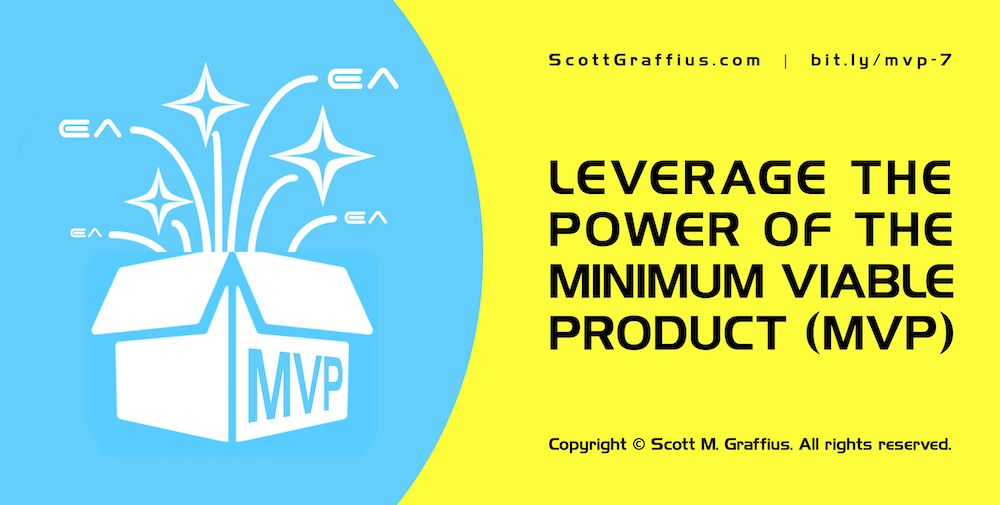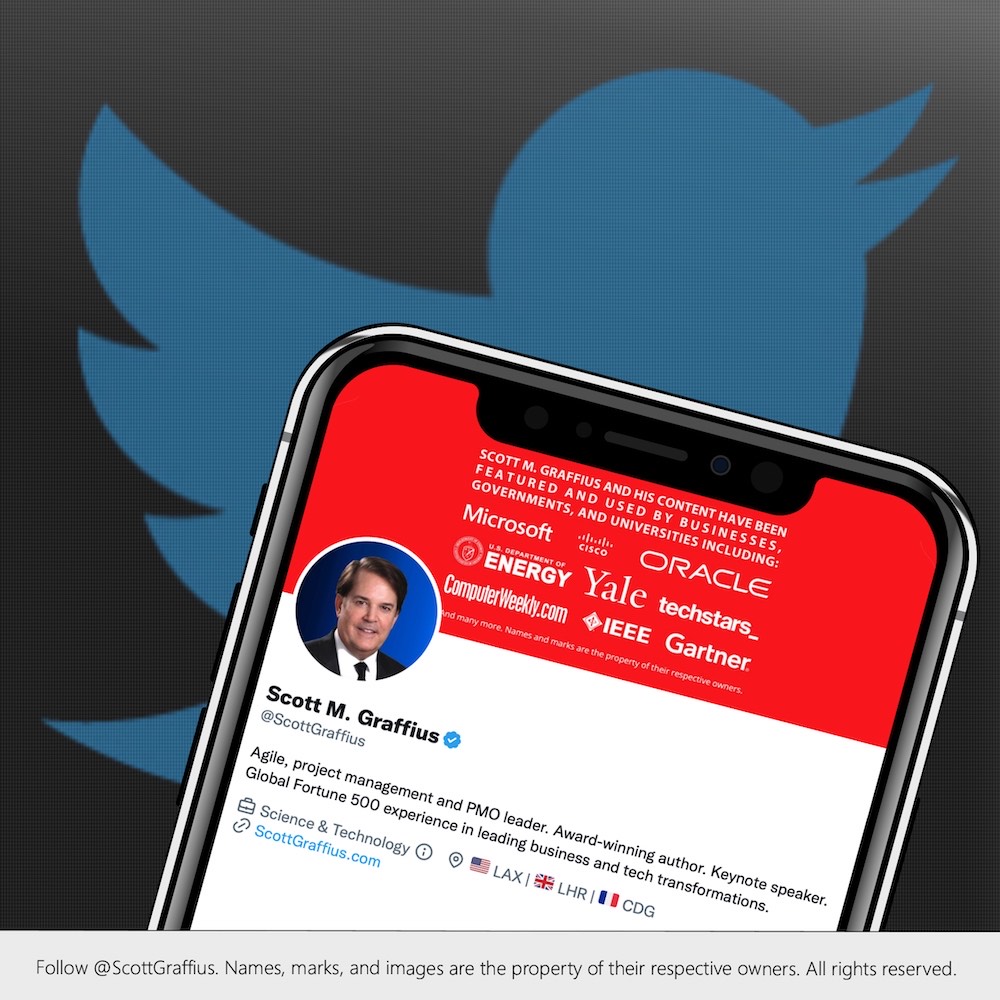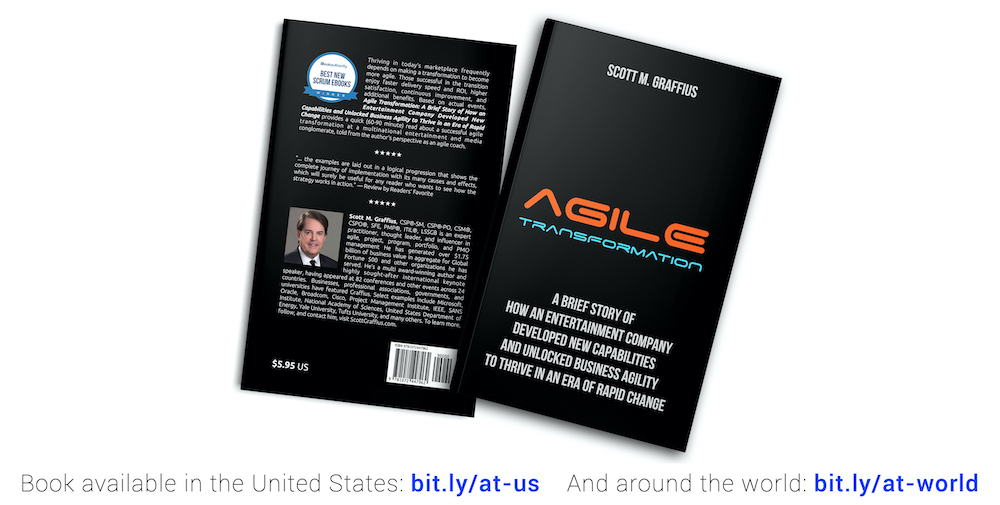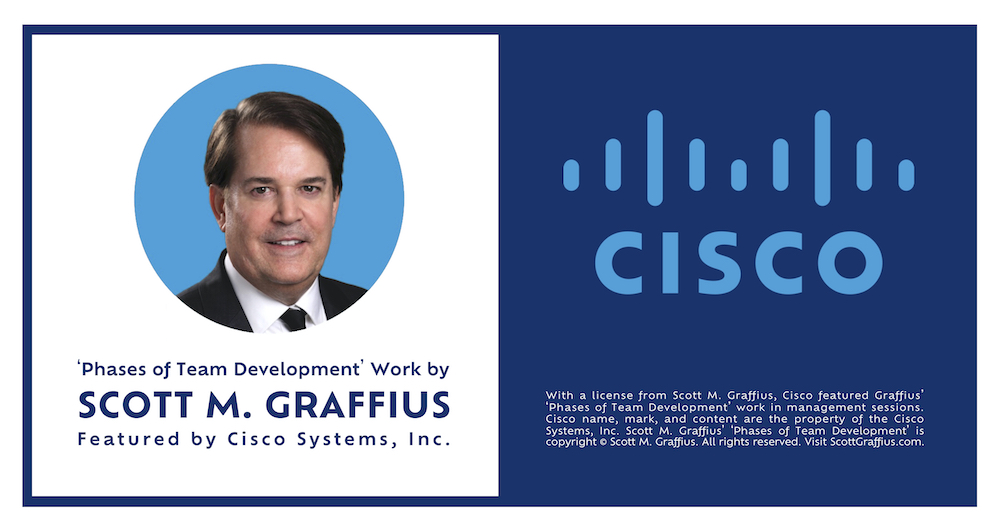Leverage the Power of the Minimum Viable Product (MVP)

Select here to download this article as a PDF.
Minimum viable products (MVPs)—coined by Frank Robinson in 2001, and subsequently popularized by Steve Blank and Eric Ries—can be advantageous tools for the development of products and services. This article is informed by Graffius' first-hand experience with MVPs as well as research and coverage from the Harvard Business Review, IEEE, MIT Sloan Management Review, Product Development and Management Association, Product School, Project Management Institute, Scaled Agile, and others (all listed in the bibliography section of this article).

Introduction
Minimum Viable Products (MVPs) can be game changers. They can be used by businesses to validate ideas, reduce time to market, and minimize risks associated with building fully featured products from the outset. This article provides those involved or interested in Agile, Lean, Product Management, Product Development, Project Management, and entrepreneurship with information on the significance of MVPs and how to leverage them.

Defining MVPs
First, it's paramount to understand what constitutes an MVP and why it matters. A Minimum Viable Product is a version of a product (or service) that incorporates just the essential features to address core customer needs and validate the viability of the concept. By employing an MVP, companies can gather valuable user feedback early on, allowing them to iterate, refine, and pivot their offering—if needed—based on market demand. This process saves time and resources, and it advances the chances of building a successful and customer-centric offering.
Here's a succinct definition of the Minimum Viable Product (MVP):
"The MVP has just those features considered sufficient for it to be of value to customers and allow for it to be shipped or sold to early adopters. Customer feedback will inform future development of the product." — Scott M. Graffius, Agile Scrum: Your Quick Start Guide with Step-by-Step Instructions
Next, examples of seven successful MVPs—Zappos, Spotify, Airbnb, Facebook, Amazon, Dropbox, and Groupon—will illustrate the power of MVPs.
MVP Success Stories
- Zappos: Zappos revolutionized the online shoe market by focusing on customer-centricity and rapid experimentation. Their MVP allowed them to validate their hypothesis, gather customer feedback, and iterate their offering to create a seamless and personalized shopping experience. Zappos is a prime example of the power of MVPs.
- Spotify: Global music streaming platform Spotify started as a simple streaming service MVP and they and continuously improved and expanded it based on customer feedback. By iterating their product, Spotify became a household name. Their MVP-driven approach ensured a product-market fit and helped them stay ahead in a competitive industry.
- Airbnb: Airbnb's success story speaks to the effectiveness of MVPs in validating an idea and subsequently scaling it to a global marketplace. Airbnb's founders started by testing their marketplace concept using an MVP strategy. By leveraging existing resources and validating demand through early adopters, they gained critical insights that shaped their platform's evolution. Today, Airbnb is a household name, offering unique accommodations worldwide.
- Facebook: Facebook's journey from a simple MVP to the world's largest social network demonstrates the power of incremental growth and user feedback. Mark Zuckerberg and fellow Harvard College students and roommates Eduardo Saverin, Andrew McCollum, Dustin Moskovitz, and Chris Hughes initially created a minimal profile-based social networking MVP (initially called "Thefacebook"), focusing on connecting people at Harvard. Through continuous iterations and the addition of features based on user needs and feedback, Facebook reshaped the social media landscape, connecting billions of people globally.
- Amazon: E-commerce giant Amazon is renowned for its relentless focus on customer experience. They started with an MVP approach, catering to customers' fundamental needs related to books, and subsequently expanded into new product categories incrementally. By prioritizing customer satisfaction, Amazon established itself as a trusted and innovative marketplace, continuously raising the bar for online shopping.
- Dropbox: Dropbox, a prominent player in the cloud storage market, kick-started its journey with a basic file-syncing MVP. By offering a simple yet essential solution to the problem of file synchronization across devices, Dropbox gained traction and valuable user insights. They leveraged this feedback to iterate and improve their product, eventually becoming a leader in the highly competitive cloud storage industry.
- Groupon: Popular online deals platform Groupon employed an MVP approach by testing deal offerings on a WordPress blog. That allowed them to validate market interest and adjust their strategy based on customer responses. By embracing the importance of market validation and adaptability, Groupon transformed into a global leader, providing users with discounted offers across various categories.
Key Principles and Best Practices for MVPs
Building a successful MVP requires adhering to key principles and best practices. It involves thoughtfully determining the relatively few features and limited scope to address core customer needs. Collecting and analyzing user feedback plays a pivotal role in making informed decisions and prioritizing enhancements. By embracing an iterative mindset and focusing on the most valuable aspects of the product, businesses can create an MVP that resonates with their target audience.
Avoiding Common Pitfalls and Challenges with MVPs
While MVPs offer significant advantages, they are not without challenges. Over-engineering the product, prematurely scaling, and failing to validate crucial assumptions are common pitfalls that can hinder success. It’s vital to strike a balance between building a viable product and avoiding unnecessary complexity. By remaining adaptable and open to change, businesses can navigate these challenges and increase the chances of achieving their goals.
Validating and Iterating via Lean and Agile Approaches
The MVP is particularly well-suited for Lean and Agile approaches and environments. Lean principles emphasize continuous learning, eliminating waste, and rapid experimentation. Agile (such as Scrum, Kanban, and SAFe) involve iterative development, frequent feedback loops, and continuous improvement. Utilizing Lean/Agile can help maximize the value of MVPs and increase chances of success.
Beyond the MVP
Once an MVP proves its viability, the focus shifts to scaling and launching the product. This stage requires a broad and deep understanding of the target market, competition, and customer preferences. It involves adapting the product based on user feedback, exploring different marketing strategies, and leveraging data-driven insights. Staying agile, continuously learning, and adapting to market dynamics are crucial for sustained growth and long-term success.

Conclusion
MVPs are powerful tools for innovation and the successful development of products/services. The examples of Zappos, Spotify, Airbnb, Facebook, Amazon, Dropbox, and Groupon highlight the transformative impact of MVPs across diverse industries. By embracing the core principles, avoiding common pitfalls, and leveraging Lean and Agile approaches, businesses can unlock the full potential of their MVPs and pave the way for sustained growth, customer satisfaction, and market leadership with their offerings. Which makes MVPs game changers.

Bibliography
- Airbnb (n.d.). About Airbnb. Available at: https://news.airbnb.com/about-us.
- Blank, Steve (2020). The Startup Owner's Manual: The Step-By-Step Guide for Building a Great Company. Hoboken, New Jersey: John Wiley and Sons.
- Cagan, Marty (2012, March 7). Viable Product vs. Minimal Product. Silicon Valley Product Group (SVPG). Available at: https://www.svpg.com/viable-product-vs-minimal-product.
- CB Insights (2021, August 3). The Top 12 Reasons Startups Fail. CB Insights Research. Available at: https://www.cbinsights.com/research/report/startup-failure-reasons-top.
- Davenport, Thomas H., & Seseri, Rudina (2020, December 15). What is a Minimum Viable AI Product? MIT Sloan Management Review. Available at: https://sloanreview.mit.edu/article/what-is-a-minimum-viable-ai-product.
- Dropbox (n.d.). About the Company. Available at: https://www.dropbox.com/about.
- Furr, Nathan, & Dyer, Jeff (2014). The Innovator's Method: Bringing the Lean Start-up into Your Organization. Boston, Massachusetts: Harvard Business Review Press.
- Graffius, Scott M. (2016). Agile Scrum: Your Quick Start Guide with Step-by-Step Instructions. North Charleston, SC: CreateSpace.
- Graffius, Scott M. (2018, October 4). Agile Scrum Helps Innovators, Disruptors, and Entrepreneurs Develop and Deliver Products at Astounding Speed Which Drives Competitive Advantage [Presentation]. Talk delivered to an audience of startups and others in the entrepreneurial community at the Techstars Startup Week Conference at The Box Theater, Riverside, California, United States. Digital Object Identifier (DOI): 10.13140/RG.2.2.25009.12647. DOI link: https://dx.doi.org/10.13140/RG.2.2.25009.12647.
- Graffius, Scott M. (2021, February 27). Are You Realizing All the Benefits from Agile? [Presentation]. Talk delivered to an audience involved or interested in Technology at the Scottish Summit 2021 Technology Conference based from Glasgow, Scotland, United Kingdom. Digital Object Identifier (DOI): 10.13140/RG.2.2.17273.90728. DOI link: https://dx.doi.org/10.13140/RG.2.2.17273.90728.
- Graffius, Scott M. (2023, May 1). Fueling the Development of Innovative and Life-Changing AI Solutions [Presentation]. Talk delivered to an audience of Technology professionals (including Data Scientists, Machine Learning Engineers, Data Engineers, AI Researchers, Project Managers, Business Analysts, UX Designers, Software Developers, Cloud Architects, Data Privacy and Security Specialists, and others involved or interested in AI) at a private event in Mountain View, California, United States. Digital Object Identifier (DOI): 10.13140/RG.2.2.27956.73601. DOI link: https://dx.doi.org/10.13140/RG.2.2.27956.73601.
- Groupon (2013, July 30). The History of Groupon. Available at: https://www.groupon.com/merchant/working-with-groupon/groupon-news/the-history-of-groupon.
- Harvard Business School (2021). MVP Development. Available at: https://entrepreneurship.hbs.edu/Documents/Session%20Summary/HBSRockMVPDevelopment.pdf.
- Krishnamurthy, Rajeshwari (2021, January 29). Why is Agile Product Development Process So Popular? Product Development & Management Association (PDMA). Available at: https://community.pdma.org/knowledgehub/bok/product-innovation-process/why-is-agile-product-development-process-so-popular.
- Lenarduzzi, Valentina, & Taibi, Davide (2016, August). MVP Explained: A Systematic Mapping Study on the Definitions of Minimal Viable Product. Proceedings from the 2016 42nd Euromicro Conference on Software Engineering and Advanced Applications (SEAA): 112–119.
- Merryweather, Ellen (2023, January 9). Product-Led Growth Strategy for Product Managers. Product School. Available at: https://productschool.com/blog/product-strategy/product-led-growth-strategy.
- Meta (n.d.). About Meta. Available at: https://about.meta.com/company-info.
- Miski, A. (2014). Development of a Mobile Application Using the Lean Startup Methodology. International Journal of Scientific & Engineering Research, 5 (1): 1743-1748.
- Moogk, Dobrila R. (2012, March). Minimum Viable Product and the Importance of Experimentation in Technology Startups. Technology Innovation and Management Review. Available at: https://timreview.ca/article/535.
- Olsen, Dan (2015). The Lean Product Playbook: How to Innovate with Minimum Viable Products and Rapid Customer Feedback. Hoboken, New Jersey: John Wiley and Sons.
- Osterwalder, Alexander, & Pigneur, Yves (2010). Business Model Generation: A Handbook for Visionaries, Game Changers, and Challengers. Hoboken, New Jersey: John Wiley and Sons.
- Project Management Institute (n.d.). Minimum Business Increments (MBIs). Available at: https://www.pmi.org/disciplined-agile/da-flex-toc/minimum-business-increments.
- Putten, Alexander B. van, & MacMillan, Ian (2004, December). Making Real Options Really Work. Harvard Business Review, 82 (12): 134-141, 150.
- Ries, Eric (2011). The Lean Startup: How Today's Entrepreneurs Use Continuous Innovation to Create Radically Successful Businesses. New York, New York: Penguin Random House.
- Scaled Agile (n.d.). Applied Innovation Accounting in SAFe. Available at: https://scaledagileframework.com/guidance-applied-innovation-accounting-in-safe.
- Spotify (n.d.). About Spotify. Available at: https://newsroom.spotify.com/company-info.
- Templeton, Chuck (2014, December 9). 10 Lessons Every Entrepreneur Should Learn. Fortune. Available at: https://fortune.com/2014/12/09/10-lessons-every-entrepreneur-should-learn.
- Thomsen, Dave (2013, December 20). Why Human-Centered Design Matters. Wired. Available at: https://www.wired.com/insights/2013/12/human-centered-design-matters.
- Umbreen, J., Mirza, Muhammad Z., Ahmad, Yasir, & Naseem, Afshan. (2022, December). Assessing the Role of Minimum Viable Products in Digital Startups. Proceedings of the 2022 IEEE International Conference on Industrial Engineering and Engineering Management (IEEM): 1073-1077.
- Wikipedia (n.d.). History of Amazon. Available at: https://en.wikipedia.org/wiki/History_of_Amazon.
- Zappos (n.d.). About Zappos. Available at: https://www.zappos.com/marty/c/about-zappos.

How to Cite This Article
Graffius, Scott M. (2023, May 15). Leverage the Power of the Minimum Viable Product (MVP). Available at: https://scottgraffius.com/blog/files/mvp2023.html. Digital Object Identifier (DOI): 10.13140/RG.2.2.24064.20486. DOI link: https://dx.doi.org/10.13140/RG.2.2.24064.20486.



About Scott M. Graffius

Scott M. Graffius, PMP, SA, CSP-SM, CSP-PO, CSM, CSPO, SFE, ITIL, LSSGB is an agile project management practitioner, consultant, multi-award-winning author, and international keynote speaker. He is the Founder of Exceptional PPM and PMO Solutions™ and subsidiary Exceptional Agility™. He has generated over $1.9 billion of business value in aggregate for Global Fortune 500 businesses and other organizations he has served. Graffius and content from his books, talks, workshops, and more have been featured and used by businesses, professional associations, governments, and universities. Examples include Microsoft, Oracle, Broadcom, Cisco, Gartner, Project Management Institute, IEEE, Qantas, National Academy of Sciences, United States Department of Energy, New Zealand Ministry of Education, Yale University, Tufts University, and others. He has delighted audiences with dynamic and engaging talks and workshops on agile, project management, and technology (including AI) leadership at 86 conferences and other events across 25 countries.
His full bio is available here.
Connect with Scott on:


About Agile Scrum: Your Quick Start Guide with Step-by-Step Instructions

Shifting customer needs are common in today's marketplace. Businesses must be adaptive and responsive to change while delivering an exceptional customer experience to be competitive.
There are a variety of frameworks supporting the development of products and services, and most approaches fall into one of two broad categories: traditional or agile. Traditional practices such as waterfall engage sequential development, while agile involves iterative and incremental deliverables. Organizations are increasingly embracing agile to manage projects, and best meet their business needs of rapid response to change, fast delivery speed, and more.
With clear and easy to follow instructions, the multi award-winning Agile Scrum: Your Quick Start Guide with Step-by-Step Instructions book by Scott M. Graffius (Chris Hare and Colin Giffen, Technical Editors) helps the reader:
- Implement and use the most popular agile framework―Scrum;
- Deliver products in short cycles with rapid adaptation to change, fast time-to-market, and continuous improvement; and
- Support innovation and drive competitive advantage.
Hailed by Literary Titan as “the book highlights the versatility of Scrum beautifully.”
Winner of 17 first place awards.
Agile Scrum: Your Quick Start Guide with Step-by-Step Instructions is available in paperback and ebook/Kindle in the United States and around the world. Some links by country follow.
- 🇧🇷 Brazil
- 🇨🇦 Canada
- 🇨🇿 Czech Republic
- 🇩🇰 Denmark
- 🇫🇮 Finland
- 🇫🇷 France
- 🇩🇪 Germany
- 🇬🇷 Greece
- 🇭🇺 Hungary
- 🇮🇳 India
- 🇮🇪 Ireland
- 🇮🇱 Israel
- 🇮🇹 Italy
- 🇯🇵 Japan
- 🇱🇺 Luxembourg
- 🇲🇽 Mexico
- 🇳🇱 Netherlands
- 🇳🇿 New Zealand
- 🇳🇴 Norway
- 🇪🇸 Spain
- 🇸🇪 Sweden
- 🇨🇭 Switzerland
- 🇦🇪 UAE
- 🇬🇧 United Kingdom
- 🇺🇸 United States

About Agile Transformation: A Brief Story of How an Entertainment Company Developed New Capabilities and Unlocked Business Agility to Thrive in an Era of Rapid Change

Thriving in today's marketplace frequently depends on making a transformation to become more agile. Those successful in the transition enjoy faster delivery speed and ROI, higher satisfaction, continuous improvement, and additional benefits.
Based on actual events, Agile Transformation: A Brief Story of How an Entertainment Company Developed New Capabilities and Unlocked Business Agility to Thrive in an Era of Rapid Change provides a quick (60-90 minute) read about a successful agile transformation at a multinational entertainment and media company, told from the author's perspective as an agile coach.
The award-winning book by Scott M. Graffius is available in paperback and ebook/Kindle in the United States and around the world. Some links by country follow.
- 🇦🇺 Australia
- 🇦🇹 Austria
- 🇧🇷 Brazil
- 🇨🇦 Canada
- 🇨🇿 Czech Republic
- 🇩🇰 Denmark
- 🇫🇮 Finland
- 🇫🇷 France
- 🇩🇪 Germany
- 🇬🇷 Greece
- 🇮🇳 India
- 🇮🇪 Ireland
- 🇯🇵 Japan
- 🇱🇺 Luxembourg
- 🇲🇽 Mexico
- 🇳🇱 Netherlands
- 🇳🇿 New Zealand
- 🇪🇸 Spain
- 🇸🇪 Sweden
- 🇨🇭 Switzerland
- 🇦🇪 United Arab Emirates
- 🇬🇧 United Kingdom
- 🇺🇸 United States

The short URL for this article is: https://bit.ly/mvp-7
© Copyright 2023 Scott M. Graffius. All rights reserved. This material may not be published, broadcast, rewritten or redistributed without the express written permission of Scott M. Graffius.

Dropbox Company (Nira) Taps into Scott M. Graffius’ Expertise in Strategic Planning

Introduction
In 2024, Dropbox, a leader in cloud storage and collaboration, broadened its vision by acquiring Nira, a company focused on boosting team productivity through innovative tools. This acquisition aligned with the launch of Dropbox Dash for Business, an AI-powered universal search tool designed to streamline workflows for over 1 billion knowledge workers worldwide.
Scott M. Graffius is honored that Dropbox company Nira has recognized his expertise in strategic planning by featuring his work in their article on retrospective meetings, credited as "Adapted by FYI from Scott Graffius" and "www.scottgraffius.com." Views follow.

This nod highlights the power of strategic planning in fostering clarity and impact—core values that resonate with Dropbox’s mission. This article explores how this recognition underscores the rising value of structured collaboration in today’s dynamic work landscape.
Main Body
Impact mapping turns abstract goals into actionable steps. It addresses four key questions—Why? Who? How? What?—to create a visual roadmap linking objectives, stakeholders, desired impacts, and deliverables. By charting the "shortest path" to success, it helps teams prioritize the most effective actions. Nira’s article on retrospective meetings—a process where teams reflect on past sprints/projects to improve future outcomes—demonstrates how impact mapping elevates this practice. By charting the effects of deliverables on key stakeholders, teams can identify what delivered value and where refinements are needed, transforming retrospectives into a springboard for progress.
Dropbox’s 2024 acquisition of Nira amplifies this emphasis on productivity and alignment. With Dash for Business, Dropbox addresses information overload by integrating search across platforms like Google Workspace and Asana, tapping into an $8 billion universal search market set to double in size. Impact mapping complements this innovation by offering strategic clarity, enabling teams to maximize tools. Nira’s inclusion of Graffius’ work signals how strategic planning bridges intent and execution, aligning with Dropbox’s aim to simplify collaboration.
Conclusion
For Graffius, recognition from Dropbox's Nira is a meaningful affirmation of universal relevance of strategic planning. He is eager to see how Dropbox continues to embed strategic clarity into its growing suite of solutions. This milestone strengthens his commitment to advancing strategic planning, shaping the future of collaboration with precision and purpose.
To learn more about impact mapping, read this article.
Read on for:
- About Nira,
- About Dropbox,
- About Scott M. Graffius,
- How to Cite This Article,
- and more.

About Nira
Nira, acquired by Dropbox, is a content governance platform that provides a suite of in-depth functionality to protect cloud files from unauthorized access. With Nira, Dropbox designed a custom solution built directly into Dash, so businesses can easily protect confidential documents in just a few clicks. Admins can now see everything that’s been shared in their company, across every major content platform, in one place. Then, they can identify sensitive content and manage bulk changes for any number of assets at once—eliminating a previously tedious and manual document-by-document process.

About Dropbox
Dropbox is the one place to keep life organized and keep work moving. With more than 700 million registered users across approximately 180 countries, it’s on a mission to design a more enlightened way of working. Dropbox is headquartered in San Francisco, California, and has employees around the world. For more information, visit https://dropbox.com.

About Scott M. Graffius

Scott M. Graffius sparks breakthroughs in AI, agile, and project management/PMO leadership as a globally recognized practitioner, researcher, thought leader, award-winning author, and international public speaker.
Graffius has generated more than USD $1.9 billion in business value for organizations served, including Fortune 500 companies. Businesses and industries range from technology (including R&D and AI) to entertainment, financial services, and healthcare, government, social media, and more.
Graffius leads the professional services firm Exceptional PPM and PMO Solutions, along with its subsidiary Exceptional Agility. These consultancies offer strategic and tactical advisory, training, embedded talent, and consulting services to public, private, and government sectors. They help organizations enhance their capabilities and results in agile, project management, program management, portfolio management, and PMO leadership, supporting innovation and driving competitive advantage. The consultancies confidently back services with a Delighted Client Guarantee™. Graffius is a former vice president of project management with a publicly traded provider of diverse consumer products and services over the Internet. Before that, he ran and supervised the delivery of projects and programs in public and private organizations with businesses ranging from e-commerce to advanced technology products and services, retail, manufacturing, entertainment, and more. He has experience with consumer, business, reseller, government, and international markets.
He is the author of two award-winning books.
- His first book, Agile Scrum: Your Quick Start Guide with Step-by-Step Instructions (ISBN-13: 9781533370242), received 17 awards.
- His second book is Agile Transformation: A Brief Story of How an Entertainment Company Developed New Capabilities and Unlocked Business Agility to Thrive in an Era of Rapid Change (ISBN-13: 9781072447962). BookAuthority named it one of the best Scrum books of all time.
Prominent businesses, professional associations, government agencies, and universities have featured Graffius and his work including content from his books, talks, workshops, and more. Select examples include:
- Adobe,
- American Management Association,
- Amsterdam Public Health Research Institute,
- Bayer,
- BMC Software,
- Boston University,
- Broadcom,
- Cisco,
- Coburg University of Applied Sciences and Arts Germany,
- Computer Weekly,
- Constructor University Germany,
- Data Governance Success,
- Deimos Aerospace,
- DevOps Institute,
- EU's European Commission,
- Ford Motor Company,
- GoDaddy,
- Harvard Medical School,
- Hasso Plattner Institute Germany,
- IEEE,
- Innovation Project Management,
- Johns Hopkins University,
- Journal of Neurosurgery,
- Lam Research (Semiconductors),
- Leadership Worthy,
- Life Sciences Trainers and Educators Network,
- London South Bank University,
- Microsoft,
- NASSCOM,
- National Academy of Sciences,
- New Zealand Government,
- Oracle,
- Pinterest Inc.,
- Project Management Institute,
- SANS Institute,
- SBG Neumark Germany,
- Singapore Institute of Technology,
- Torrens University Australia,
- TBS Switzerland,
- Tufts University,
- UC San Diego,
- UK Sports Institute,
- University of Galway Ireland,
- US Department of Energy,
- US National Park Service,
- US Tennis Association,
- Veleučilište u Rijeci Croatia,
- Verizon,
- Virginia Tech,
- Warsaw University of Technology,
- Wrike,
- Yale University,
- and many others.
Graffius has been actively involved with the Project Management Institute (PMI) in the development of professional standards. He was a member of the team which produced the Practice Standard for Work Breakdown Structures—Second Edition. Graffius was a contributor and reviewer of A Guide to the Project Management Body of Knowledge—Sixth Edition, The Standard for Program Management—Fourth Edition, and The Practice Standard for Project Estimating—Second Edition. He was also a subject matter expert reviewer of content for the PMI’s Congress. Beyond the PMI, Graffius also served as a member of the review team for two of the Scrum Alliance’s Global Scrum Gatherings.
Graffius has a bachelor’s degree in psychology with a focus in Human Factors. He holds eight professional certifications:
- Certified SAFe 6 Agilist (SA),
- Certified Scrum Professional - ScrumMaster (CSP-SM),
- Certified Scrum Professional - Product Owner (CSP-PO),
- Certified ScrumMaster (CSM),
- Certified Scrum Product Owner (CSPO),
- Project Management Professional (PMP),
- Lean Six Sigma Green Belt (LSSGB), and
- IT Service Management Foundation (ITIL).
He is an active member of the Scrum Alliance, the Project Management Institute (PMI), and the Institute of Electrical and Electronics Engineers (IEEE).
He divides his time between Los Angeles and Paris, France.
Thought Leader | Public Speaker | Agile Scrum Book | Agile Transformation Book | Blog | Photo | X | LinkedIn | Email













Sign up for Miro—it's free!
(Want more features? You can always upgrade to a paid plan.)


How to Cite This Article
Graffius, Scott M. (2025, March 21). Reporting Errors in 'Frontiers in Public Health': A Case Study. Available at: https://scottgraffius.com/blog/files/dropbox-taps-into-scott-m-graffius-expertise-in-strategic-planning.html. 

Digital Object Identifier (DOI)
DOI: (coming soon)

Content Acknowledgements
This article includes brief excerpts from content ('12 Tricks for Running a Retrospective Meeting that People Actually Enjoy') by Dropbox company Nira, attributed and used under fair use for news reporting and analysis. Dropbox name and mark are the property of Dropbox Inc. Nira is the property of Dropbox Inc.

Post-Publication Notes
If there's an update after this article is published, the information will appear here.

Copyright
Copyright © Scott M. Graffius. All rights reserved.
Content on this site—including text, images, videos, and data—may not be used for training or input into any artificial intelligence, machine learning, or automatized learning systems, or published, broadcast, rewritten, or redistributed without the express written permission of Scott M. Graffius.
